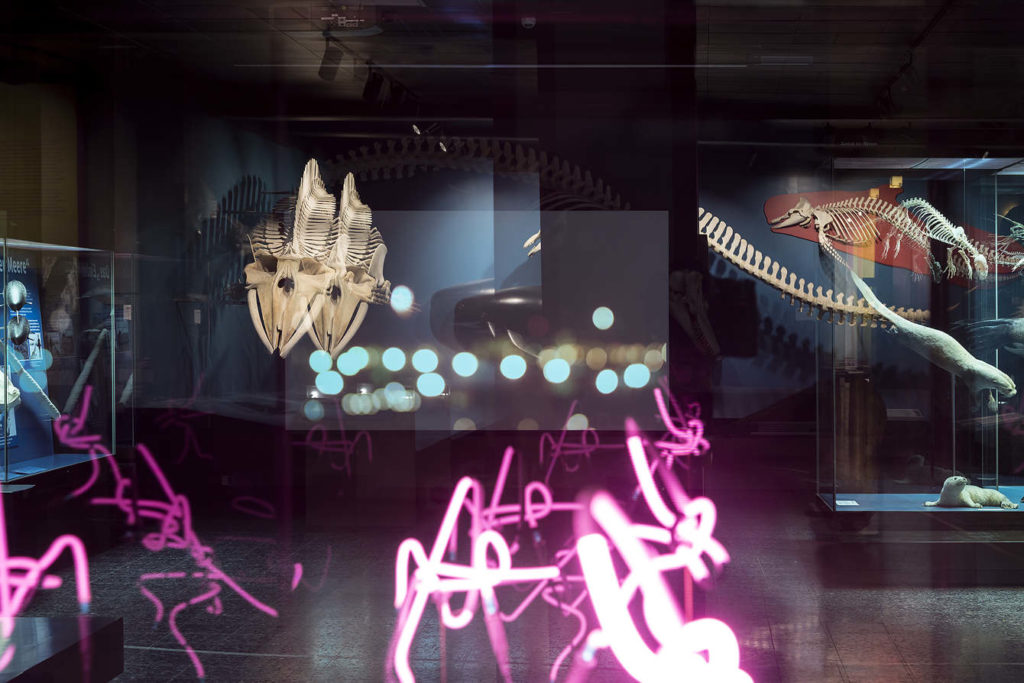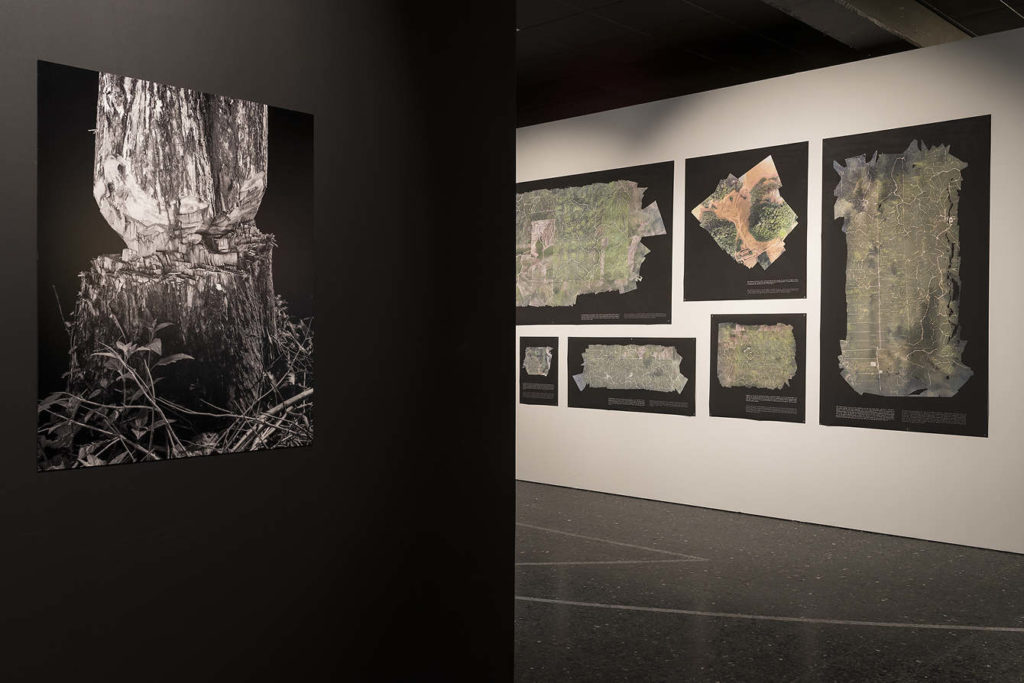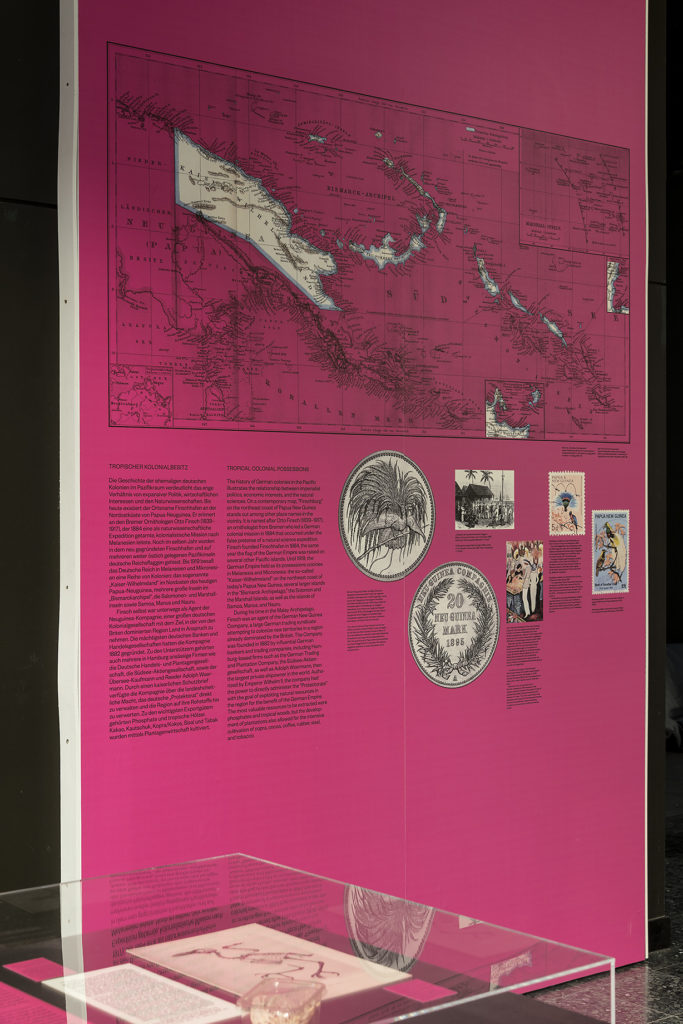Verschwindende Vermächtnisse: Die Welt als Wald
[ Disappearing Legacies: The World as Forest ]
First iteration of the three-part exhibition cycle
10 November 2017 – 29 March 2018
Centrum für Naturkunde (CeNak)
Zoologisches Museum Hamburg
Bundesstrasse 52
D-20146 Hamburg
One-hundred and sixty years ago, Alfred Russel Wallace deciphered the principle of species evolution during research trips to South America and Southeast Asia. From 10 November 2017 to 29 March 2018, the special exhibition Verschwindende Vermächtnisse: Die Welt als Wald [Disappearing Legacies: The World as a Forest] confronts the destruction of these tropical habitats in the context of the Anthropocene and mass extinction.
The concept of the project is unique—a hybrid between a historical thematic presentation and a major exhibition of contemporary art, transforming the Zoological Museum im Centrum für Naturkunde (CeNak), University of Hamburg, into a threatened (rain)forest habitat. The centerpiece of the intervention is the presentation of 13 contemporary works of art—including eight new commissions—by Maria Thereza Alves, Ursula Biemann, Bik Van der Pol, Shannon Lee Castleman, Revital Cohen & Tuur van Balen, Mark Dion, Radjawali Irendra / Akademi Drone Indonesia, Armin Linke with Giulia Bruno and Giuseppe Ielasi, Barbara Marcel, Julian Oliver & Crystelle Vũ, Robert Zhao Renhui / The Institute of Critical Zoologists, SHIMURAbros und autonoma / Paulo Tavares.
Some of the works have a direct relation to the University of Hamburg’s collections. Through on-site visits, the artist Robert Zhao Renhui from Singapore, for instance, has further developed his ongoing exploration of our ambiguous relationship with insects by selecting a series of objects from CeNak’s Entomology Collection for his room-size installation. And it was a visit to the Mammalogy Collection that inspired the artist duo Bik Van der Pol to engage in a deeper examination of the phenomenon of nature as a replica situated between reality and fiction.
Other artistic works were developed through journeys to Brazil and Indonesia. Spending time on Borneo, Java, and Sumatra, photographer and filmmaker Armin Linke—together with his colleague Giulia Bruno and exhibition curators Anna-Sophie Springer and Etienne Turpin—conducted numerous interviews with local residents, plantation workers, small land holders, environmentalists, government officials, and scientists. The result is a cinematic document that reflects the speed with which Indonesia is currently transforming into a palm-oil nation amid giant peat fires. In her museum installation, Maria Thereza Alves lends the word to 33 Indigenous clan chiefs, whom she accompanied for one month last summer in Brazil while participating in a workshop on Indigenous agroforestry and resource conservation. Revital Cohen & Tuur van Balen look inward and examine taxidermy birds with piercing X-ray vision, while the automated multimedia installation Extinction Gong by Julian Oliver & Crystelle Vũ translates the IUCN Red List of Endangered Species into an eerie and percussive rhythm in realtime.
The exhibition is extended by a series of curatorial assemblages, which include specimens from the CeNak’s zoological collections and the botanical collections of the Herbarium Hamburgense that were selected in dialogue with the respective institutions’ scientific curators: skulls, animal skins, spirit specimens, herbarium sheets, and numerous cases of colorful pinned insects.
Another special highlight is the 3D digital rendering of a Sumatran rhino skull, produced in collaboration with YXLON International, a Hamburg-based high-resolution industrial CT-scanner developer, and a special data visualization software from Volume Graphics. Other media include exclusive screenings of one of Sir David Attenborough’s earliest BBC documentaries and a selection of videos from the ornithologist Ed Scholes (Cornell Lab of Ornithology) and wildlife photographer Tim Laman’s ambitious Bird-of-Paradise Project.
Together, the artistic positions and curatorial assemblages presented in the exhibition Verschwindende Vermächtnisse: Die Welt als Wald renounce a romantic image of untouched nature, and instead critically inquire into the legacies resulting from the relentless destruction of highly complex ecosystems.
Alongside the exhibition, CeNak offers a variegated event program comprising of guided tours, lectures, screenings, and other evening events. Entry is free.
10 November 2017 – 29 March 2018
Opening: 9 November 2017, 18h00
Centrum für Naturkunde (CeNak)
Zoologisches Museum Hamburg
Bundesstrasse 52
D-20146 Hamburg
Contact:
+49 40 42 838 2276
info-cenak@uni-hamburg.de
More info on the project at CeNak, or read an interview with the curators.
Verschwindende Vermächtnisse: Die Welt als Wald is a three-part project by Anna-Sophie Springer and Etienne Turpin. The travelling exhibition is realized by Centrum für Naturkunde, University of Hamburg, where it will be on view from 10 November 2017 until 29 March 2018. In 2018, adapted iterations will be presented at the project partners, Tieranatomische Theater (TA T), Humboldt University Berlin, and the Zentralmagazin Naturwissenschaftlicher Sammlungen, Martin-Luther-Universität Halle-Wittenberg, Halle/Saale. The exhibition cycle is a cooperation with the Schering Stiftung and the Goethe-Institut. Ursula Biemann’s participation is supported by Pro Helvetia. The project is funded by the German Federal Cultural Foundation.
[ The “Tree” font used in the graphic design is an open-source project by artist Katie Holten. Exhibition documentation by Michael Pfisterer, Hamburg]

















































































